Excertos do catálogo
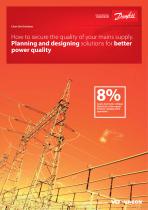
Clean Grid Solutions How to secure the quality of your mains supply. Planning and designing solutions for better power quality mains harmonic voltage distortion is the upper limit for reliable plant operation.
Abrir o catálogo na página 1
Electrical devices and their environmental impact 6 Electromagnetic factors work in both directions 6 System responsibility rests with the operator 6 Basic principle of interference effects 7 Transmission paths of interference 7 First environment: residential, commercial and light industrial areas 8 Second environment: industrial environment 8 Radio frequency interference 9 Standards and directives define limits 9 The perfect mains voltage 10 Power quality - what are the key factors? 10 Technical solutions for the reliable supply of good power 11 How good is...
Abrir o catálogo na página 3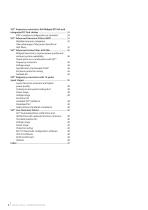
EMC-compliant configuration as standard 34 Reliable harmonic mitigation 35 Take advantage of the proven benefits of AHF filters: 35 Mitigate harmonics, improve power quality and enhance system availability 36 Stand-alone or in combination with VLT® frequency converters 36 Specification of achievable THDi* 36 Enclosure protection rating 36 Lower harmonic emissions and higher power quality 38 Cooling via rear panel cooling duct 38 Enclosure 38 Available VLT® platforms 38 Helps achieve standards compliance 38 VLT® AutomationDrive, HVAC Drive and AQUA Drive with...
Abrir o catálogo na página 4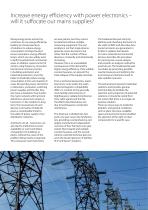
Rising energy prices are forcing customers to use energy efficiently, leading to a broad spectrum of solutions to reduce energy consumption. Perhaps the best known example is energy-efficient lamps, which are now widely used in both household and commercial areas. In addition, speed control of motors using frequency converters has become common practice in building automation and industrial production, since this helps to drastically reduce energy consumption in the vast majority of cases. But just like power electronics in televisions, computers, switching power supplies and the like,...
Abrir o catálogo na página 5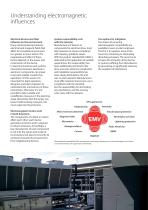
RFI suppression Radioactivity stSS. Immunity Electrical devices and their influence on the environment Every electrical device produces electrical and magnetic fields that affect its immediate environment to a greater or lesser extent. The magnitude and effect of these factors depend on the power and construction of the device. In electrical machines and systems, interactions between electrical or electronic components can impair or prevent reliable, trouble-free operation. For this reason it is important for plant operators, designers and plant engineers to understand the mechanisms of...
Abrir o catálogo na página 6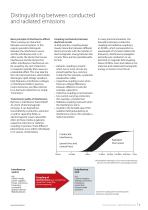
Distinguishing between conducted and radiated emissions Basic principle of interference effects There is always an interaction between several systems. In this regard, specialists distinguish between the interference source and the interference sink, or in other words, the device that causes interference and the device that suffers interference. Interference can be caused by any sort of electrical or magnetic quantity that causes an undesirable effect. This may take the form of mains harmonics, electrostatic discharges, rapid voltage variations, high-frequency interference voltages or...
Abrir o catálogo na página 7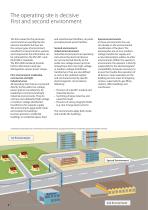
The operating site is decisive First and second environment Special environments In these environments the user can decide on the environmental classification of the plant. The prerequisites are an own mediumvoltage transformer supply and a clear demarcation relative to other environments. Within the operator’s environment, the operator is directly responsible for the electromagnetic compatibility measures necessary to ensure the trouble-free operation of all devices. Some examples are the building services areas of shopping centres, supermarkets, gas filling stations, office buildings and...
Abrir o catálogo na página 8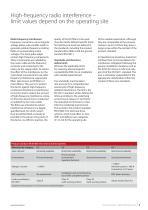
Radio frequency interference Frequency converters use rectangular voltage pulses with variable width to generate variable-frequency rotating fields at corresponding motor voltages. The steep pulse edges contain high-frequency components. These components are radiated by the motor cable and the frequency converter and conducted to the mains via the supply cable. To reduce the effect of this interference on the mains feed, manufacturers use radio frequency interference suppression filters (also known as RFI filters or mains filters). They serve to protect the device against...
Abrir o catálogo na página 9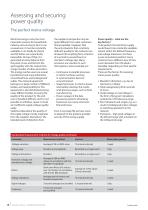
Electrical energy is now the most important resource for households, industry and commerce. But it is an unusual one: it must be constantly available, it can hardly be stored, and QC before use is practically impossible. On top of that, it is generated at some distance from the point of use, and fed into the grid together with the output from a large number of other generators. The energy reaches users via several transformers and many kilometres of overhead lines and underground cables. The network equipment belongs to a large number of different bodies, and responsibility for...
Abrir o catálogo na página 10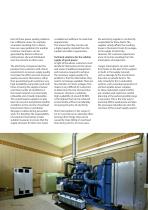
Each of these power quality problems has a different cause. For example, a transient resulting from a blown fuse can cause problems for another customer. Harmonics can be generated by devices within an endcustomer site and distributed over the network to other users. The electricity companies take the position that customers with critical requirements on power supply quality must take the effort and cost of power quality assurance themselves, rather than guaranteeing all customers very high availability everywhere and at all times. Ensuring the supply of power at all times under all...
Abrir o catálogo na página 11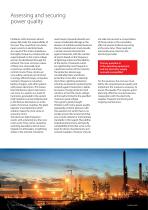
Problems with harmonics almost always fall under the responsibility of the user. They result from non-linear input currents in electrical loads. As a result of the mains impedance, the higher frequency components are superimposed on the mains voltage and can be distributed through the network. The most common causes of these non-sinusoidal input currents are rectifier and phase control circuits. These circuits are very widely used and can be found in energy-efficient lamps, computers, monitors, frequency converters, battery chargers, and other systems with power electronics. This means that...
Abrir o catálogo na página 12Todos os catálogos e folhetos técnicos Danfoss VLT Drives
-
Danfoss Drives VLT® Options
122 Páginas
-
VLT® Advanced Active Filter AAF 006
2 Páginas
-
VACON® 100
32 Páginas
-
VLT® Decentral Drive FCD 300
4 Páginas
-
Operating Instructions Profibus DP V
53 Páginas
-
Danfoss Drives – for your applications
24 Páginas
-
VACON® NXP DCGuard™
90 Páginas
-
Danfoss Drives Options Portfolio
122 Páginas
-
Danfoss Drives - for your applications
28 Páginas
-
VLT® OneGearDrive
40 Páginas
-
VLT® 12-pulse drive
2 Páginas
-
Danfoss Drives Fieldbus Solutions
12 Páginas
-
DrivePro® Life Cycleservices
8 Páginas
-
TP5001 Range
92 Páginas
-
VLT® DriveMotor: FCM 106 / FCP 106
12 Páginas
-
VLT® DriveMotor FCM 106
2 Páginas
-
VLT® DriveMotor FCM 300
2 Páginas
-
VLT® Power Option Sine-Wave Filter
2 Páginas
-
VLT® Power Option dU/dt Filter
2 Páginas
-
VLT® AutomationDrive
2 Páginas
-
VLT® AQUA Drive
2 Páginas
-
VLT® AQUA Drive
36 Páginas
-
VLT® drives up to 90 kW
2 Páginas
-
VLT® Panel Optimised Drives
2 Páginas
-
VLT® HVAC Drive
2 Páginas
-
VLT® HVAC Drive
40 Páginas
-
VLT® Refrigeration Drive FC 103
2 Páginas
-
VLT® Drives FC Series
16 Páginas
-
Danfoss VLT Drives
8 Páginas
-
Smart savings in automated systems
16 Páginas
-
Danfoss Drives
12 Páginas
-
VLT®
20 Páginas
-
VLT 2800
34 Páginas
-
VLT® Product Catalogue
60 Páginas
-
Danfoss VLT® Softstarter
8 Páginas
-
VLT® Decentral Drive FCD 302
2 Páginas
-
VLT® OneGearDrive
2 Páginas
-
Harmonics mitigation
16 Páginas
-
VLT® HVAC Drive
40 Páginas
-
MCC 101 Sine wave filters
2 Páginas
-
VLT® Decentral FCD 300
8 Páginas
-
VLT® DriveMotor FCM 300
8 Páginas
-
VLT® Micro Drive
8 Páginas
-
VLT® 2800 Series
5 Páginas
-
VLT® AQUA Drive FC 200
16 Páginas
-
VLT® HVAC Drive FC 100
20 Páginas






















































